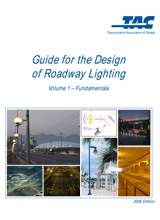This Guide is intended to promote uniformity in lighting across Canada by providing guidance in the planning and design of roadway lighting and related outdoor lighting systems. The publication is divided into two major sections – Fundamentals and Design:
1) “Fundamentals” contains information on lighting theory, obtrusive light, the planning and design process, standards and codes, calculations and the use of computer software in roadway design and maintenance.
2) “Design” applies the principles and information presented in the first section to specific facilities that may require lighting, such as roadways, interchanges, intersections, roundabouts and tunnels. Also included are off-road facilities such as pedestrian and bicycle pathways, weigh scales, rest areas and road signs. This section also provides guidelines for streetscapes, temporary roadway lighting and work zone lighting for road construction areas.
The Guide offers warranting criteria for each roadway application, with the warrants provided as a point-score system, a narrative definition or a combination of both. In addition, the Guide covers a number other related topics. It emphasizes that roadway lighting, if properly designed, installed and maintained, should reduce vehicle collisions, improve safety for cyclists and pedestrians and enhance personal security. It also discusses ongoing trends in the development of more energy-efficient light sources, as well as the need to consider alternatives to lighting.
$100 from the sale of each Guide is placed in a designated TAC reserve fund to support future updates and revisions of the Guide.
Disponible en français : Guide de conception des systèmes d’éclairage routier (2006)


